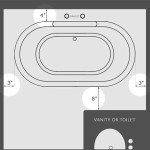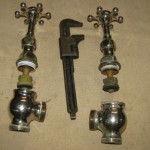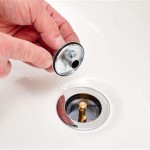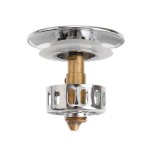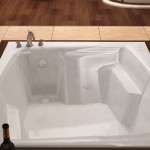Why Is Water Coming Out Of My Bathtub Faucet?
The persistent dripping or continuous flow of water from a bathtub faucet, even when it is supposedly turned off, is a common household plumbing issue. This seemingly minor problem can escalate into a significant inconvenience, leading to wasted water, increased water bills, and potential damage to the fixture and surrounding areas. Understanding the underlying causes of this issue is crucial for effective diagnosis and repair.
Several factors can contribute to water leakage from a bathtub faucet. These reasons range from simple wear and tear of internal components to more complex issues within the plumbing system. A systematic approach to identifying the root cause is necessary to determine the appropriate solution. This article will explore some of the most common reasons for a leaky bathtub faucet and provide insights into potential remedies.
Worn or Damaged Washers
One of the most frequent culprits behind a dripping bathtub faucet is a worn or damaged washer. Washers are small, rubber or neoprene rings that create a watertight seal when the faucet is turned off. These seals are located within the faucet assembly and are crucial for preventing water from escaping when the valve is closed. Over time, the constant pressure and friction exerted on the washers can cause them to deteriorate, crack, or become brittle. This degradation compromises their ability to form a tight seal, resulting in a leak.
Mineral deposits from hard water can also accelerate the wear and tear of washers. These deposits accumulate on the surface of the washer, creating a rough and uneven texture that prevents it from properly seating against the valve seat. This irregular surface allows water to seep through, leading to the characteristic dripping sound. The type of faucet also dictates the type of washer. Compression faucets are particularly susceptible to washer problems due to their design, which relies heavily on the washer to completely shut off the water flow.
Diagnosing a worn or damaged washer typically involves disassembling the faucet handle and examining the condition of the washer. If the washer appears cracked, misshapen, or significantly worn, it should be replaced with a new one of the same size and type. It is important to ensure the new washer is properly seated and secured within the faucet assembly to prevent future leaks. When replacing a washer, it is often advisable to replace all washers within the faucet at the same time, even if only one appears damaged. This proactive approach can prevent future leaks and save time and effort in the long run.
Furthermore, the valve seat, the surface against which the washer presses, can also become corroded or damaged over time. This damage can prevent the washer from properly sealing, even if the washer itself is in good condition. In such cases, the valve seat may need to be cleaned or replaced to ensure a proper seal.
Defective O-Rings
O-rings are small, circular rubber gaskets used in various types of faucets, particularly cartridge and ball-type faucets. These O-rings create a seal between different faucet components, preventing water from escaping. Similar to washers, O-rings are subject to wear and tear from constant water exposure and friction. As they age, O-rings can become brittle, cracked, or flattened, losing their ability to maintain a watertight seal. This degradation can lead to leaks around the faucet handle or spout.
The location of the leak can provide clues about which O-ring is failing. Leaks around the faucet handle often indicate a problem with the O-rings that seal the cartridge or ball assembly. Leaks from the spout may suggest issues with O-rings located within the spout itself. Identifying the specific O-ring responsible for the leak requires careful inspection of the faucet assembly.
Replacing O-rings involves disassembling the faucet and removing the old O-rings. It is crucial to use the correct size and type of O-ring for the specific faucet model. Before installing the new O-rings, it is recommended to lubricate them with plumber's grease. This lubrication helps the O-rings slide into place easily and prevents them from drying out and cracking prematurely. Properly installed and lubricated O-rings can effectively prevent leaks and extend the lifespan of the faucet.
Cartridge faucets, in particular, rely heavily on O-rings for their smooth operation and leak-free performance. Regular inspection and replacement of O-rings in cartridge faucets can prevent costly repairs and ensure consistent water flow. Ball-type faucets also utilize O-rings and springs to maintain a tight seal and control water flow. Replacing these components as needed can prevent leaks and maintain the functionality of the faucet.
Corroded Valve Seat
The valve seat is the stationary part of the faucet against which the washer presses to shut off the water flow. Over time, particularly in areas with hard water, the valve seat can become corroded or damaged. Mineral deposits, such as calcium and lime, accumulate on the valve seat, creating a rough and uneven surface. This irregular surface prevents the washer from properly sealing, allowing water to leak through even when the faucet is turned off.
Corrosion of the valve seat can also be caused by chemical reactions between the metal of the valve seat and the water. Certain types of water treatments or cleaning products can accelerate this corrosion process. The resulting damage can range from minor pitting to significant erosion of the valve seat surface. In severe cases, the valve seat may become so damaged that it is no longer possible to achieve a watertight seal, even with a new washer.
Addressing a corroded valve seat requires either cleaning or replacing the valve seat. If the corrosion is minor, it may be possible to clean the valve seat using a valve seat wrench or a specialized valve seat dressing tool. These tools are designed to smooth out the surface of the valve seat and remove mineral deposits. However, if the corrosion is extensive, the valve seat may need to be replaced entirely. Replacing the valve seat typically involves removing the faucet body and using a valve seat wrench to unscrew the old valve seat and install a new one.
Preventing valve seat corrosion involves using water softeners or filters to reduce the mineral content of the water. Regular cleaning of the faucet and surrounding areas can also help prevent the buildup of mineral deposits. Avoiding harsh chemicals and abrasive cleaners can minimize the risk of chemical corrosion. By taking these preventative measures, homeowners can extend the lifespan of their faucets and reduce the likelihood of leaks caused by valve seat corrosion.
Loose or Damaged Cartridge
Cartridge faucets utilize a cartridge, a cylindrical component that controls the mixing and flow of water. Over time, the cartridge can become loose within the faucet body, leading to leaks around the handle or spout. The cartridge can also become damaged due to wear and tear, mineral buildup, or physical impact. A damaged cartridge may not properly shut off the water flow, resulting in a constant drip or stream from the faucet.
Identifying a loose or damaged cartridge typically involves observing the faucet's performance. If the faucet handle feels loose or wobbly, or if the water flow is inconsistent, it may indicate a problem with the cartridge. Leaks around the base of the handle are another common sign of a cartridge issue. To confirm the diagnosis, the faucet handle needs to be removed to expose the cartridge.
Replacing a cartridge involves shutting off the water supply to the faucet, removing the handle and trim, and then extracting the old cartridge. It is essential to use the correct type of cartridge for the specific faucet model. Before installing the new cartridge, it is recommended to clean the faucet body and apply plumber's grease to the cartridge seals. This lubrication helps the cartridge slide into place smoothly and prevents leaks. Once the new cartridge is installed, the handle and trim can be reassembled. Ensuring the cartridge is properly seated and secured is crucial for preventing future leaks and maintaining the smooth operation of the faucet.
The lifespan of a cartridge can vary depending on the water quality, usage frequency, and the quality of the cartridge itself. Regularly inspecting the cartridge for signs of wear or damage can help prevent unexpected leaks and ensure the continued performance of the faucet. When replacing a cartridge, it is often advisable to choose a high-quality replacement cartridge from a reputable manufacturer to ensure long-lasting performance and reliability.
High Water Pressure
Excessively high water pressure within the plumbing system can also contribute to leaks from a bathtub faucet. High water pressure puts undue stress on the faucet's internal components, including washers, O-rings, and cartridges. This increased pressure can accelerate the wear and tear of these components, leading to premature failure and leaks. Extreme high water pressure can even damage the faucet body itself, causing cracks or fractures that result in significant leaks.
The ideal water pressure for most homes is between 40 and 60 pounds per square inch (PSI). Water pressure above 80 PSI is considered excessively high and can pose a risk to plumbing fixtures and appliances. Homeowners can check their water pressure using a pressure gauge, which can be attached to an outdoor faucet or a laundry machine connection. If the water pressure is consistently above 80 PSI, it is necessary to take steps to reduce it.
Installing a pressure-reducing valve (PRV) on the main water line is the most effective way to control high water pressure. A PRV regulates the water pressure entering the home, ensuring that it remains within a safe and manageable range. PRVs are typically installed by a qualified plumber and can be adjusted to maintain the desired water pressure. In addition to installing a PRV, homeowners can also consider installing water hammer arrestors on plumbing lines to absorb the shock of sudden pressure changes. These arrestors can help protect plumbing fixtures from damage caused by water hammer, a phenomenon that occurs when water flow is abruptly stopped.
Addressing high water pressure not only prevents leaks from bathtub faucets but also protects other plumbing fixtures and appliances throughout the home. Maintaining a safe water pressure ensures the longevity and efficient operation of the entire plumbing system, saving homeowners money on repairs and replacements in the long run.

How To Fix A Leaking Bathtub Faucet The Home Depot

How To Fix A Leaking Bathtub Faucet The Home Depot

How To Fix A Leaking Bathtub Faucet Diy Family Handyman

How To Fix A Leaking Bathtub Faucet The Home Depot

Why Is My Bathtub Faucet Leaking After The Water Turned Off Ranshaw

How To Fix A Leaking Bathtub Faucet The Home Depot

How To Fix Water That Keeps Running In A Tub Faucet Southwest Plumbing

How To Fix A Leaking Bathtub Faucet The Home Depot

Shower Diverter Problem Can Be Quickly Fixed Home And Garden Life

Water Leaking From Under The Bathtub Possible Causes And Solutions

